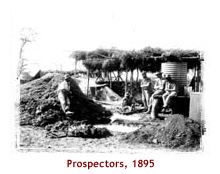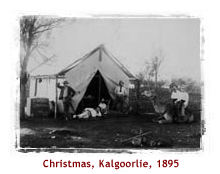Gold"W.A. is a fraud - The curse of the country is gold, as sheep are the curse of the East. A more sordid, vulgar condition of things would be impossible to conceive. The old sand-gropers are the best to work for or to have dealings with. The Othersiders are cutting each others throats. W.A. is a huge camp of adventurers and failures."  The
discovery of gold in Western Australia was a long awaited and much anticipated
event. Although there had been several small discoveries in the Kimberley
in the late 1880s, the discovery of significant deposits of alluvial gold
in Coolgardie (1892) and Kalgoorlie (1893) triggered a boom which broke
more than six decades of economic stagnation. The
discovery of gold in Western Australia was a long awaited and much anticipated
event. Although there had been several small discoveries in the Kimberley
in the late 1880s, the discovery of significant deposits of alluvial gold
in Coolgardie (1892) and Kalgoorlie (1893) triggered a boom which broke
more than six decades of economic stagnation.Henry Lawson spent three months in Perth during 1896 before returning to the East when he ran out of money and optimism, never making it as far as the goldfields. He was just one of tens of thousands of t'othersiders who flocked to the West to find their fortunes. For most, all they found were hardships. The miners of the goldfields were, for the most part, unhappy with the Forrest government in Perth. Individual representatives like Frederick Vosper gave voice to their grievances while the goldfields became a stronghold of the union movement - the West Australian Labor Party also had its origins in a conference held at Kalgoorlie in 1899.  For
Western Australia, gold brought prosperity. Increased government revenues
from licences, fees, tariffs and other taxes enabled Forrest to undertake
major public works programs such as the supply of water
to the goldfields and other regional areas. More importantly the boom brought
much needed people to the colony. Once deposits of alluvial gold began to
run out, miners settled in the colony providing labour for industries and
settlers for new farming areas. For
Western Australia, gold brought prosperity. Increased government revenues
from licences, fees, tariffs and other taxes enabled Forrest to undertake
major public works programs such as the supply of water
to the goldfields and other regional areas. More importantly the boom brought
much needed people to the colony. Once deposits of alluvial gold began to
run out, miners settled in the colony providing labour for industries and
settlers for new farming areas.Most importantly the influx of immigrants brought with it new ideas and a sense of vibrancy, giving renewed vitality to the colony. From a population of 46,000 in 1890 the new State of Western Australia recorded a population of 180,000 in the first census of 1901. |
Please note: The content on this website is made available for archival purposes and may not meet the State Library of Western Australia's current standards for web accessibility, mobile device compatibility, historical accuracy and cultural sensitivity.